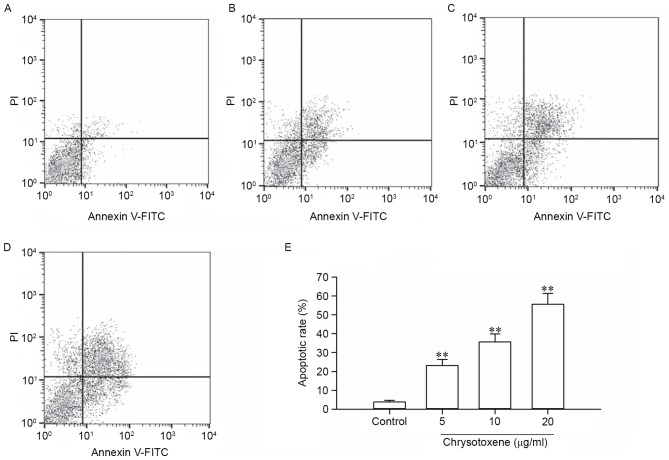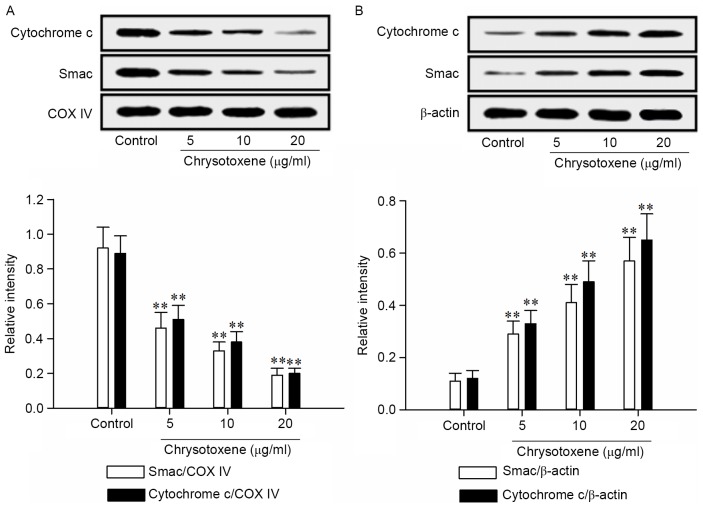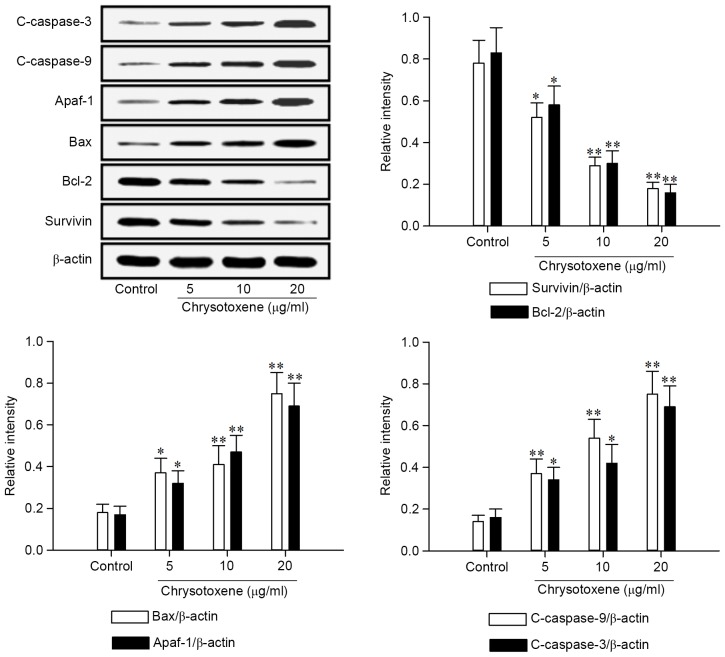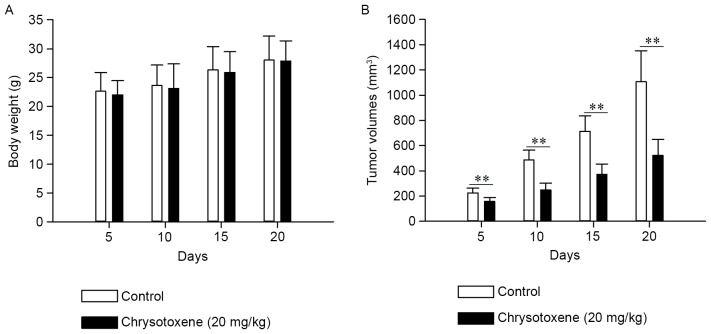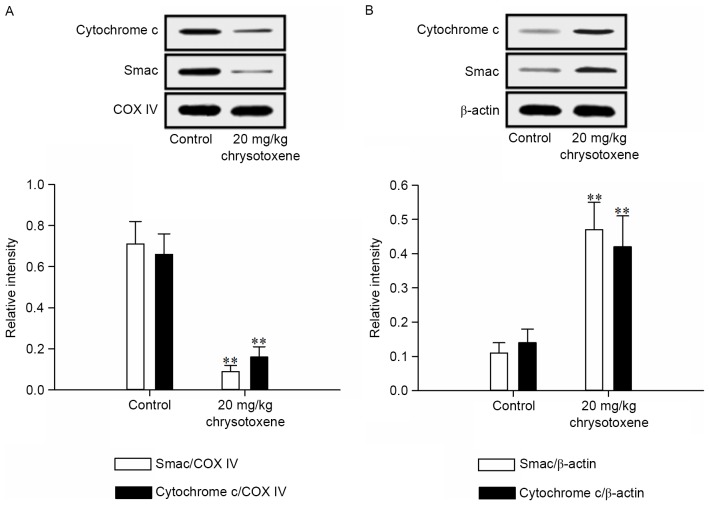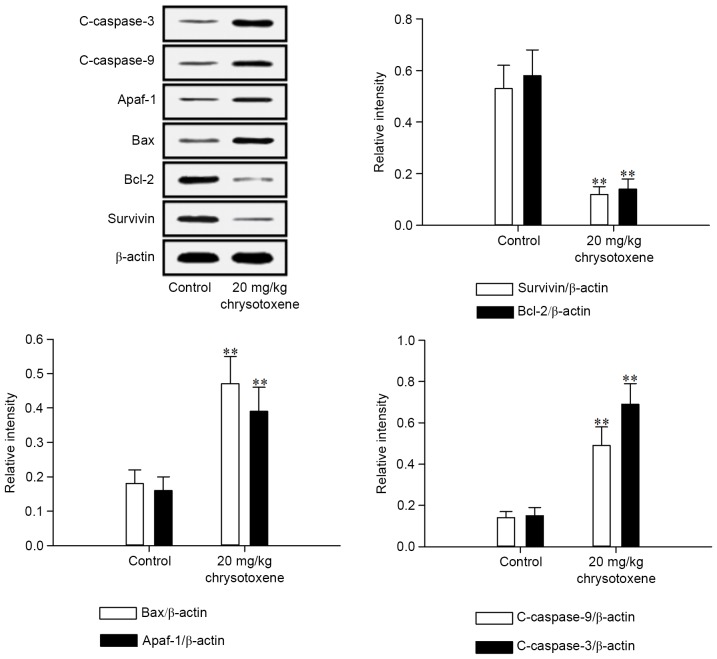Abstract
Previous studies have indicated that chrysotoxene may be a potential drug used to treat tumors, however the effect of chrysotoxene on hepatoblastoma remains unknown. Therefore, the present study aimed to investigate the cytotoxic effect and elucidate the potential molecular mechanism of chrysotoxene on human hepatoblastoma HepG2 cells. Chrysotoxene (5–40 µg/ml) exhibited cytotoxic activity against HepG2 cells with inhibitory rates of 24.67–84.06% (half maximal inhibitory concentration, 19.64 µg/ml), observed from a Cell Counting Kit-8 assay. The results of flow cytometry analysis indicated that chrysotoxene (5, 10 or 20 µg/ml) significantly (P<0.01) induced the apoptosis of HepG2 cells with apoptotic rates of 23.14, 35.68 and 55.61% respectively, compared with the control group. The results of western blot analysis indicated that chrysotoxene (5, 10 or 20 µg/ml) significantly (P<0.05) promoted the release of second mitochondria-derived activator of caspase (Smac) and Cytochrome c from the mitochondria to the cytoplasm, downregulated Survivin and B cell lymphoma-2 (Bcl-2) proteins levels, and upregulated Bcl-2-associated X factor (Bax), apoptotic protease activating factor-1 (Apaf-1), cleaved (c)-caspase-9 and c-caspase-3 protein levels in HepG2 cells, compared with the control group. The results of xenograft analysis indicated that chrysotoxene (20 mg/kg) significantly (P<0.01) inhibited the growth of HepG2 cell-induced tumors by regulating the aforementioned apoptotic proteins (Smac, Cytochrome c, Survivin, Bcl-2, Bax, Apaf-1, c-caspase-9 and c-caspase-3), compared with the control group. In conclusion, chrysotoxene induced the apoptosis of HepG2 cells in vitro and in vivo via activation of the mitochondria-mediated apoptotic signaling pathway, suggesting that it may be a potential candidate drug for treating patients with hepatoblastoma.
Keywords: chrysotoxene, HepG2 cells, cytotoxic effect, apoptosis, mitochondria-mediated apoptotic signaling pathway
Introduction
Hepatoblastoma is the most common primary malignant hepatic tumor experienced in infancy and childhood globally (1). Chemotherapy drugs serve a vital function in treating hepatoblastoma (2). Long-term use of chemotherapy drugs is necessary to effectively control the condition of patients with hepatoblastoma; however, the long-term use of chemotherapy drugs may induce drug resistance in hepatoblastoma cells, resulting in the decreased efficacy of chemotherapy drugs (3). Therefore, the identification of safe and effective chemotherapy drugs for treating hepatoblastoma is required. Recently, the use of plant-derived chemical constituents with anti-tumor activity has been increasingly studied for their potential use as chemotherapy drugs (4).
Chrysotoxene is a phenanthrene derivative that was first isolated from Dendrobium (D.) chrysotoxum Lindl (Orchidaceae) and has previously demonstrated inhibitory effects on the growth of hepatoma and ehrlich ascites carcinoma in mice (5). Chrysotoxene exhibited cytotoxic activity against cultured chronic myelogenous leukemia K562 cells using microscopic cell counting and morphological observation (6). These two previous studies revealed that chrysotoxene may be a potential drug used to treat tumors, however the anti-tumor mechanism of chrysotoxene remains unknown. The aim of the present study was to investigate the cytotoxic effect and possible mechanism of chrysotoxene on human hepatoblastoma HepG2 cells in vitro and in vivo. First, the cytotoxic effect of chrysotoxene on HepG2 cells was assessed using a Cell Counting Kit (CCK)-8 assay. Second, flow cytometry analysis was used to investigate whether the cytotoxic effect of chrysotoxene on HepG2 cells was associated with apoptosis. Subsequently, the effect of chrysotoxene on apoptotic proteins in the mitochondria-mediated apoptotic signaling pathway were investigated using western blot analysis. Finally, the effect and mechanism of chrysotoxene on HepG2 cell-induced tumors in nude mice were investigated. The results of these assays demonstrated that chrysotoxene induced the apoptosis of HepG2 cells in vitro and in vivo via activation of the mitochondria-mediated apoptotic signaling pathway.
Materials and methods
Chemicals and reagents
Analytical grade solvent (ethanol, petroleum ether and chloroform) and silica-gel (200–300 mesh) were purchased from Qingdao Haiyang Chemical Co., Ltd. (Qingdao, China). RPMI 1640 media and fetal bovine serum (FBS) were purchased from Invitrogen (Thermo Fisher Scientific, Inc., Waltham, MA, USA). Total Protein Extraction kit (cat no. SD-001), Mitochondria Protein Extraction kit (cat no. MP-007), and Cytoplasm Protein Extraction kit (cat no. SM-005) were provided by Beijing BioDee Diagnostics Co., Ltd. (Beijing, China). Dimethyl sulfoxide (DMSO) was purchased from Sigma-Aldrich (Merck KGaA, Darmstadt, Germany). CCK-8 and enhanced Bicinchoninic Acid (BCA) protein assay kits were purchased from Beyotime Institute of Biotechnology (Shanghai, China). The cell staining buffer was purchased from BioPike, LLC. (Shanghai, China). Annexin V-fluorescein isothiocyanate (FITC)/propidium iodide (PI) apoptosis assay kit was purchased from Shanghai Standard Biotech Co., Ltd. (Shanghai, China). Primary antibodies for second mitochondria-derived activator of caspase (Smac; Cat no. 15108; rabbit anti-human; 1:1,000), apoptotic protease activating factor-1 (Apaf-1; Cat no. 8969; rabbit anti-human; 1:1,000), cleaved (c)-caspase-9 (Cat no. 9501; rabbit anti-human; 1:1,000) and β-actin (Cat no. 3700; mouse anti-human; 1:1,000) were purchased from Cell Signaling Technology, Inc. (Danvers, MA, USA), whereas antibodies against Cytochrome c (Cat no. AC909; mouse anti-human; 1:200), B cell lymphoma-2 (Bcl-2; Cat no. AB112; rabbit anti-human; 1:1,000), Bcl-2-associated X factor (Bax; Cat no. AB026; mouse anti-human; 1:500), Survivin (Cat no. AS792; rabbit anti-human; 1:1,000), c-caspase-3 (Cat no. AC033; rabbit anti-human; 1:1,000), Cytochrome c oxidase IV (COX IV; Cat no. AC610; rabbit anti-human; 1:1,000) and horseradish peroxidase (HRP)-conjugated secondary antibody (goat anti-mouse: Cat no. A0216; 1:1,000. Goat anti-rabbit: Cat no. A0208; 1:1,000) were purchased from Beyotime Institute of Biotechnology (Shanghai, China). Enhanced chemiluminescence detection kit for HRP were provided by Biological Industries (Kibbutz Beit-Haemek, Israel).
Animals
A total of 20 male nude mice (five-six weeks old, 20±2 g) were obtained from the Animal Laboratory of The First Affiliated Hospital of Chinese People's Liberation Army General Hospital (Beijing, China) and housed in a temperature-controlled vivarium (25°C) with a relative humidity of 65% and a 12/12-h light-dark cycle. All animals had free access to water and food. All assays involving animals were strictly conducted in accordance with the National Institute of Health, Guide for the Care and Use of Laboratory Animals (7). All assays involving animals were performed with the approval of the Animal Experimentation Ethics Committee of the First Affiliated Hospital of Chinese People's Liberation Army General Hospital (protocol no. ECFAHCPLAGH 2014251). The humane endpoint was when the tumor size in the control group was 3 times greater compared with the treatment group, or the humane endpoint was when the tumor size was <2,000 mm3.
Extraction, isolation and identification of chrysotoxene
D. chrysotoxum was obtained from www.zyctd.com in 2014, and its authenticity was verified by Dr Ming-Ming Han based on corresponding morphological and microscopic identification characteristics. A voucher specimen (voucher no. GCSH201401) was stored in the Department of Pharmaceutical Medicine Science, The First Affiliated Hospital of Chinese PLA General Hospital for future reference at room temperature.
D. chrysotoxum (15 kg) was extracted thrice with refluxing 95% ethanol and the extracting solvent was combined and evaporated under decreased pressure (−0.1 MPa) to afford a crude extract (400 g). Subsequently, the crude extract was subjected to column chromatography over silica-gel column (200–300 mesh), eluted with systemic gradient (10% increase) of petroleum ether-chloroform to obtain different fractions (500 ml/fraction). Chrysotoxene (162 mg) was obtained from fractions 149–156, and the corresponding elution solvent was petroleum ether-chloroform (7:3). The purity, molecular formula and chemical structure of chrysotoxene were analyzed by high performance liquid chromatography (HPLC), mass spectrometry and nuclear magnetic resonance (NMR), respectively. HPLC analysis was performed on the LC-20AT system (Shimadzu Corporation, Japan), and the chromatographic separation was performed in an Inertsil ODS-SP C18 column (4.6×250 mm, 5 µm) (Shimadzu Corporation), operated at 30°C. The mobile phase, injection volume, flow rate and detection wavelength were methanol-acetonitrile-water (60:60:165), 10 µl, 1 ml/min and 237 nm, respectively. The purity of chrysotoxene was defined as the rate of chrysotoxene peak area to total peak area in HPLC chromatogram. Mass spectrometry analysis was performed on the 1290 HPLC-6500 Q-TOF (Agilent Technologies, Inc., Santa Clara, CA, USA) with an electronic spray ion (ESI) source under TOF mode (negative mode) to analyze the molecular formula of chrysotoxene based on its deprotonated molecule ([M-H]−). The ESI source parameters nitrogen gas temperature, nebulizer pressure and drying gas flow rate were 325°C, 40 psi and 10 l/min, respectively. NMR analysis was performed on the DPX-400 (Bruker Corporation, Germany), according to the manufacturer's protocol. Chrysotoxene was dissolved in 0.5% DMSO to obtain required concentrations for assays.
Cell culture
HepG2 cells were obtained from the American Type Culture Collection (Manassas, VA, USA) and cultured in RPMI-1640 medium supplemented with 10% FBS and antibiotics (100 U/ml penicillin and 100 U/ml streptomycin). HepG2 cells were maintained in a humidified incubator at 37°C and 5% CO2 and sub-cultured until reaching logarithmic growth phase.
CCK-8 assay
HepG2 cells were seeded on 96-well plates at a density of 2×104 cells/well. Following incubation for 4 h, HepG2 cells were treated with chrysotoxene (5, 10, 15, 20, 25, 30, 35 or 40 µg/ml) or 0.5% DMSO (control group). Subsequent to incubation for 48 h at 37°C, 10 µl CCK-8 was added into each well and cells were cultured for another 3 h prior to the optical density (OD) of each sample being measured at 450 nm using a Bio-Rad Laboratories, Inc. Model 680 microplate reader (Hercules, CA, USA). The inhibitory rate of chrysotoxene against viability of HepG2 cells was calculated using the following equation (8): Inhibitory rate(%)=(ODcontrol-ODchrysotoxene)/ODcontrol ×100.
Flow cytometry assay
Following treatment with chrysotoxene (5, 10 or 20 µg/ml) or 0.5% DMSO for 48 h at 37°C, HepG2 cells were harvested and washed with PBS solution. The washed HepG2 cells were re-suspended in cell staining buffer and stained with 5 µl Annexin V-FITC/10 µl PI for 15 min at room temperature. Subsequently, the stained HepG2 cells were analyzed using a flow cytometer and Cell Quest Acquisition Software v. 5.1 (BD Biosciences, Franklin Lakes, NJ, USA).
Western blot analysis
Following treatment with chrysotoxene (5, 10 or 20 µg/ml) or 0.5% DMSO for 48 h at 37°C, HepG2 cells were harvested and washed with PBS solution. Subsequently, the mitochondrial protein, cytoplasmic protein and total protein of HepG2 cells were extracted using corresponding kits, respectively, and their concentrations were determined by enhanced BCA protein assay kit. The mitochondrial protein and cytoplasmic protein were used to investigate the effect of chrysotoxene on the release of Smac and Cytochrome c from mitochondria to the cytoplasm in HepG2 cells. The total protein was used to investigate the effect of chrysotoxene on Bcl-2, Bax, Survivin, Apaf-1, c-caspase-9 and c-caspase-3 protein levels in HepG2 cells. Equal amount of proteins (~40 µg) were separated by SDS-PAGE (12% gel) and then transferred onto polyvinylidene difluoride (PVFD) membrane. Following blocking with 5% no-fat milk, the PVDF membrane was incubated with corresponding primary antibodies overnight at 4°C, and subsequently with HRP-conjugated secondary antibodies for 2 h at room temperature. Finally, the proteins were detected by chemiluminescence with the aid of enhanced chemiluminescence detection kit for HRP. The mitochondrial protein level was represented as protein level/COX IV level, and the total or cytoplasmic protein level was represented as protein level/β-actin level; COX IV and β-actin were used as reference proteins.
Xenograft assay
Nude mice were randomly divided into 2 groups (n=10 in each group): Control and chrysotoxene groups. Nude mice were subcutaneously injected in the right flank with HepG2 cells at a density of 2×106 cells/mouse. When the HepG2 cell-induced tumors achieved a diameter of ~3 mm, the nude mice in the control or chrysotoxene group were administrated orally with 0.5% DMSO or 20 mg/kg chrysotoxene once a day for 20 days, respectively. The width and length of tumors in each mouse and the body weight of each mouse were measured on day 5, 10, 15 and 20 using Vernier calipers and an electronic balance. The maximum weight mice achieved prior to decapitation was <35 g. Subsequently, nude mice were directly sacrificed by decapitation in order to obtain the tumor tissues used for western blot assay, which was performed as aforementioned. Based on width and length of tumor, tumor volume was calculated using the following equation (8): Tumor volume (mm3)=(width2 × length)/2.
Statistical analysis
All experiments were performed in triplicate and data are represented as mean ± standard deviation. Differences between groups were analyzed using one-way analysis of variance followed by Least Significance Difference multiple comparisons test on SPSS 21.0 (IBM Corp., Armonk, NY, USA). P<0.05 was considered to indicate a statistically significant difference.
Results
Purity and identification of chrysotoxene
The purity of chrysotoxene was >99.5% based on the result of area normalization method of HPLC. The chemical structure of chrysotoxene (Fig. 1) was identified by comparing its mass spectrometry and NMR data with the reported literature (9,10).
Figure 1.
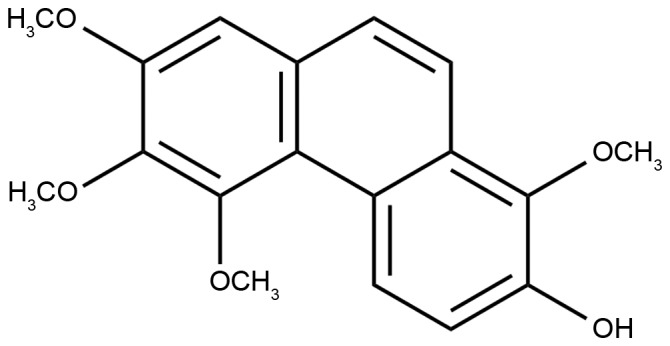
Chemical structure of chrysotoxene.
Chrysotoxene exhibited cytotoxic activity against, and induced apoptosis of, HepG2 cells
As presented in Fig. 2, chrysotoxene (5, 10, 15, 20, 25, 30, 35 or 40 µg/ml) exhibited cytotoxic activity against HepG2 cells in a dose-dependent manner, with inhibitory rates of between 24.67 and 84.06%; the half maximal inhibitory concentration value was 19.64 µg/ml. As presented in Fig. 3, compared with that in the control group, chrysotoxene (5, 10 or 20 µg/ml) significantly (P<0.01) induced apoptosis of HepG2 cells with apoptotic rates of 23.14, 35.68 and 55.61%, respectively. These results indicated that the cytotoxic activity of chrysotoxene against HepG2 cells was associated with apoptosis. Therefore, the effect of chrysotoxene on apoptotic proteins in the mitochondria-mediated apoptotic signaling pathway was further investigated to explore the possible mechanism of chrysotoxene on apoptosis of HepG2 cells.
Figure 2.
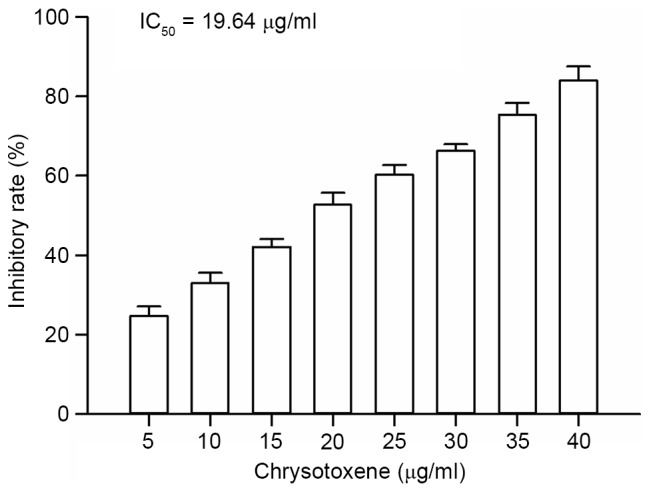
Cytotoxic activity of chrysotoxene against HepG2 cells. IC50, half maximal inhibitory concentration.
Figure 3.
Inductive effect of chrysotoxene on apoptosis of HepG2 cells. Results are presented for the (A) control, (B) 5 µg/ml chrysotoxene, (C) 10 µg/ml chrysotoxene and (D) 20 µg/ml chrysotoxene groups. (E) Graph depicting the apoptotic rates of distinct concentrations of chrysotoxene. **P<0.01 vs. the control group. FITC, fluorescein isothiocyanate; PI, propidium iodide.
Chrysotoxene regulated apoptotic proteins in the mitochondria-mediated apoptotic signaling pathway
As presented in Fig. 4, chrysotoxene (5, 10 or 20 µg/ml) significantly (P<0.01) promoted the release of Smac and Cytochrome c from the mitochondria to the cytoplasm in HepG2 cells, compared with the control group. Following treatment with chrysotoxene (5, 10 or 20 µg/ml), Survivin and Bcl-2 proteins levels in HepG2 cells were significantly (P<0.05) downregulated, and Bax, Apaf-1, c-caspase-9 and c-caspase-3 proteins levels in HepG2 cells were significantly (P<0.05) upregulated, compared with the control group (Fig. 5).
Figure 4.
Stimulative effect of chrysotoxene on the release of Smac and Cytochrome c from the mitochondria to the cytoplasm in HepG2 cells. (A) Smac and Cytochrome c protein levels in the mitochondria. (B) Smac and Cytochrome c protein levels in the cytoplasm. **P<0.01 vs. the control group. Smac, second mitochondria-derived activator of caspase; COX IV, Cytochrome c oxidase IV.
Figure 5.
Regulative effect of chrysotoxene on Survivin, Bcl-2, Bax, Apaf-1, c-caspase-9 and c-caspase-3 proteins levels in HepG2 cells. *P<0.05, **P<0.01 vs. the control group. Bcl-2, B cell lymphoma-2; Bax, Bcl-2-associated X factor; Apaf-1, apoptotic protease activating factor-1; c-, cleaved.
Chrysotoxene inhibited growth of HepG2 cell-induced tumors in nude mice
As presented in Fig. 6, chrysotoxene (20 mg/kg) significantly (P<0.01) inhibited the growth of HepG2 cell-induced tumors in nude mice without demonstrating a significant effect on the body weight, compared with the control group. As presented in Fig. 7, chrysotoxene (20 mg/kg) significantly (P<0.01) promoted the release of Smac and Cytochrome c from the mitochondria to the cytoplasm in HepG2 cell-induced tumor tissue compared with those in the control group. Following treatment with chrysotoxene (20 mg/kg), Survivin and Bcl-2 proteins levels in HepG2 cell-induced tumor tissue were significantly (P<0.01) downregulated, and Bax, Apaf-1, c-caspase-9 and c-caspase-3 proteins levels in HepG2 cell-induced tumor tissue were significantly (P<0.01) upregulated, compared with those in the control group (Fig. 8).
Figure 6.
Effect of chrysotoxene on the growth of HepG2 cell-induced tumors and body weight of nude mice. (A) Body weight of nude mice. (B) Volumes of HepG2 cell-induced tumors. **P<0.01 vs. the control group.
Figure 7.
Stimulative effect of chrysotoxene on the release of Smac and Cytochrome c from the mitochondria to the cytoplasm in HepG2 cell-induced tumor tissue. (A) Smac and Cytochrome c protein levels in the mitochondria. (B) Smac and Cytochrome c proteins levels in cytoplasm. **P<0.01 vs. the control group. Smac, second mitochondria-derived activator of caspase; COX IV, Cytochrome c oxidase IV.
Figure 8.
Regulative effect of chrysotoxene on survivin, Bcl-2, Bax, Apaf-1, c-caspase-9 and c-caspase-3 protein levels in HepG2 cell-induced tumor tissue. **P<0.01 vs. the control group. Bcl-2, B cell lymphoma-2; Bax, Bcl-2-associated X factor; Apaf-1, apoptotic protease activating factor-1; c-, cleaved.
Discussion
In the present study, the cytotoxic activity and possible molecular mechanism of chrysotoxene against HepG2 cells were investigated by CCK-8, flow cytometry, western blot and xenograft assays. CCK-8 assay is a commonly used assay to evaluate the cytotoxic activity of chemical constituents against cancer cells (11). Flow cytometry analysis is a commonly used assay to explore whether the cytotoxic activity of chemical constituents against cancer cells is associated with apoptosis (12). The results of CCK-8 and flow cytometry assays in the present study suggested that chrysotoxene demonstrated cytotoxic activity against HepG2 cells and the cytotoxic activity may be induced by apoptosis (Figs. 2 and 3).
Induction of apoptosis of cancer cells is an important pathway utilized by chemotherapy drugs to treat cancer (13). The mitochondria-mediated apoptotic signaling pathway serves a critical function in inducing apoptosis of cancer cells (14). Smac, Cytochrome c, Bcl-2, Bax, Survivin, Apaf-1, c-caspase-9 and c-caspase-3 are primarily regulative proteins in the mitochondria-mediated apoptotic signaling pathway (15). Apoptotic stimuli may promote the release of Smac and Cytochrome c from the mitochondria to the cytoplasm, which may be inhibited by Bcl-2 (16–18). Bax is able to decrease the inhibitory effect of Bcl-2 on the release of Smac and Cytochrome c (19). Cytochrome c in the cytoplasm, Apaf-1 and procaspase-9, along with deoxyadenosine triphosphate form apoptosomes, which result in the cleavage of procaspase-9 (c-caspase-9) (20). C-caspase-9 can induce the cleavage of procaspase-3 (c-caspase-3), which induces apoptosis of cells (21). The cleavage of procaspase-3 caused by c-caspase-9 can be inhibited by Survivin, whose function can be attenuated by Smac in the cytoplasm (22,23). The results of western blot analysis in the present study indicated that chrysotoxene induced the apoptosis of HepG2 cells by promoting the release of Smac and Cytochrome c from the mitochondria to the cytoplasm, downregulating Survivin and Bcl-2 protein levels, and upregulating Bax, Apaf-1, c-caspase-9 and c-caspase-3 protein levels (Figs. 4 and 5).
Xenograft analysis on nude mice is a commonly applied method to assess the in vivo anti-tumor activity of chemical constituents (24). The results of the xenograft assay in the present study demonstrated that chrysotoxene inhibited the growth of HepG2 cell-induced tumors without affecting the body weight of nude mice (Fig. 6). The results of western blot analysis of HepG2 cell-induced tumor tissues suggested that the mechanism of action of chrysotoxene was associated with the activation of the mitochondria-mediated apoptotic signaling pathway by regulating the aforementioned apoptotic proteins (Figs. 7 and 8).
In conclusion, the results of the present study demonstrated that chrysotoxene induced apoptosis of HepG2 cells in vitro and in vivo via activation of the mitochondria-mediated apoptotic signaling pathway. Therefore, chrysotoxene may possess potential to be developed into an anti-hepatoblastoma therapeutic agent. However, investigations into the mechanism of action of chrysotoxene require further investigation.
References
- 1.Sharma D, Subbarao G, Saxena R. Hepatoblastoma. Semin Diagn Pathol. 2017;34:192–200. doi: 10.1053/j.semdp.2016.12.015. [DOI] [PubMed] [Google Scholar]
- 2.Reyes JD, Carr B, Dvorchik I, Kocoshis S, Jaffe R, Gerber D, Mazariegos GV, Bueno J, Selby R. Liver transplantation and chemotherapy for hepatoblastoma and hepatocellular cancer in childhood and adolescence. J Pediatr. 2000;136:795–804. doi: 10.1016/S0022-3476(00)44469-0. [DOI] [PubMed] [Google Scholar]
- 3.Yu L, Hu Y, Duan JH, Yang XD. A novel approach of targeted immunotherapy against adenocarcinoma cells with nanoparticles modified by CD16 and MUC1 aptamers. J Nanomater. 2015;2015:316968. doi: 10.1155/2015/316968. [DOI] [Google Scholar]
- 4.McAllister SD, Soroceanu L, Desprez PY. The antitumor activity of plant-derived non-psychoactive cannabinoids. J Neuroimmune Pharmacol. 2015;10:255–267. doi: 10.1007/s11481-015-9608-y. [DOI] [PMC free article] [PubMed] [Google Scholar]
- 5.Ma GX, Xu GJ, Xu LS. Inhibitory effects of Dendrobium chrysotoxum and its constituents on the mouse HePA and ESC. J Chin Pharmaceut Univ. 1994;25:188–189. [Google Scholar]
- 6.Wang TS, Lu YM, Ma GX, Pan Y, Xu GJ, Xu LS, Wang ZT. In vitro inhibition activities of leukemia K562 cells growth by constituents from D. chrysotoxum. Nat Prod Res Dev. 1997;9:1–3. [Google Scholar]
- 7.The National Research Council of The National Academy of Sciences: Guide for the care and use of aboratory animals. Eight. Washington, DC: The National Academies Press; 2010. [Google Scholar]
- 8.Zheng Z, Qiao Z, Gong R, Wang Y, Zhang Y, Ma Y, Zhang L, Lu Y, Jiang B, Li G, et al. Uvangoletin induces mitochondria-mediated apoptosis in HL-60 cells in vitro and in vivo without adverse reactions of myelosuppression, leucopenia and gastrointestinal tract disturbances. Oncol Rep. 2016;35:1213–1221. doi: 10.3892/or.2015.4443. [DOI] [PubMed] [Google Scholar]
- 9.Ma GX, Xu GJ, Xu LS, Wang ZT, Kichuchi T. Studies on chemical constituents of Dendrobium chrysotoxum Lindl. Acta Pharm Sin. 1994;29:763–766. [Google Scholar]
- 10.Jiang Y, Zhong M, Peng W. Qualitative analysis of plant-derived samples by liquid chromatography-electrospray ionization-quadrupole-time of flight-mass spectrometry. Trop J Pharm Res. 2015;14:925–930. doi: 10.4314/tjpr.v14i5.25. [DOI] [Google Scholar]
- 11.Xiong S, Zheng Y, Jiang P, Liu R, Liu X, Chu Y. MicroRNA-7 inhibits the growth of human non-small cell lung cancer A549 cells through targeting BCL-2. Int J Biol Sci. 2011;7:805–814. doi: 10.7150/ijbs.7.805. [DOI] [PMC free article] [PubMed] [Google Scholar]
- 12.Upreti D, Pathak A, Kung SK. Development of a standardized flow cytometric method to conduct longitudinal analyses of intracellular CD3ζ expression in patients with head and neck cancer. Oncol Lett. 2016;11:2199–2206. doi: 10.3892/ol.2016.4209. [DOI] [PMC free article] [PubMed] [Google Scholar]
- 13.Safarzadeh E, Sandoghchian Shotorbani S, Baradaran B. Herbal medicine as inducers of apoptosis in cancer treatment. Adv Pharm Bull. 2014;4(Suppl 1):S421–S427. doi: 10.5681/apb.2014.062. [DOI] [PMC free article] [PubMed] [Google Scholar]
- 14.Li-Weber M. Targeting apoptosis pathways in cancer by Chinese medicine. Cancer Lett. 2013;332:304–312. doi: 10.1016/j.canlet.2010.07.015. [DOI] [PubMed] [Google Scholar]
- 15.Shi YG. A structure view of mitochondria-mediated apoptosis. Nat Struct Biol. 2001;8:394–401. doi: 10.1038/87548. [DOI] [PubMed] [Google Scholar]
- 16.Qin S, Yang C, Wang X, Xu C, Li S, Zhang B, Ren H. Overexpression of Smac promotes cisplatin-induced apoptosis by activating caspase-3 and caspase-9 in lung cancer A549 cells. Cancer Biother Radiopharm. 2013;28:177–182. doi: 10.1089/cbr.2012.1261. [DOI] [PubMed] [Google Scholar]
- 17.Guo XL, Liang B, Wang XW, Fan FG, Jin J, Lan R, Yang JH, Wang XC, Jin L, Cao Q. Glycyrrhizic acid attenuates CCl4-induced hepatocyte apoptosis in rats via a p53-mediated pathway. World J Gastroenterol. 2013;19:3781–3791. doi: 10.3748/wjg.v19.i24.3781. [DOI] [PMC free article] [PubMed] [Google Scholar]
- 18.Renault TT, Teijido O, Antonsson B, Dejean LM, Manon S. Regulation of Bax mitochondrial localization by Bcl-2 and Bcl-x L: Keep your friends close but your enemies closer. Int J Biochem Cell Biol. 2013;45:64–67. doi: 10.1016/j.biocel.2012.09.022. [DOI] [PubMed] [Google Scholar]
- 19.Czabotar PE, Lessene G, Strasser A, Adams JM. Control of apoptosis by the BCL-2 protein family: implications for physiology and therapy. Nat Rev Mol Cell Biol. 2014;15:49–63. doi: 10.1038/nrm3722. [DOI] [PubMed] [Google Scholar]
- 20.Yuan S, Akey CW. Apoptosome structure, assembly and procaspase activation. Structure. 2013;21:501–515. doi: 10.1016/j.str.2013.02.024. [DOI] [PMC free article] [PubMed] [Google Scholar]
- 21.Würstle ML, Laussmann MA, Rehm M. The central role of initiator caspase-9 in apoptosis signal transduction and the regulation of its activation and activity on the apoptosome. Exp Cell Res. 2012;318:1213–1220. doi: 10.1016/j.yexcr.2012.02.013. [DOI] [PubMed] [Google Scholar]
- 22.Wang LH, Li HH, Li M, Wang S, Jiang XR, Li Y, Ping GF, Cao Q, Liu X, Fang WH, et al. SL4, a chalcone-based compound, induces apoptosis in human cancer cells by activation of the ROS/MAPK signalling pathway. Cell Prolif. 2015;48:718–728. doi: 10.1111/cpr.12226. [DOI] [PMC free article] [PubMed] [Google Scholar]
- 23.Alrieri DC. Targeting survivin in cancer. Cancer Lett. 2013;332:225–228. doi: 10.1016/j.canlet.2012.03.005. [DOI] [PMC free article] [PubMed] [Google Scholar]
- 24.Khan N, Bharali DJ, Adhami VM, Siddiqui IA, Cui H, Shabana SM, Mousa SA, Mukhtar H. Oral administration of naturally occurring chitosan-based nanoformulated green tea polyphenol EGCG effectively inhibits prostate cancer cell growth in a xenograft model. Carcinogenesis. 2014;35:415–423. doi: 10.1093/carcin/bgt321. [DOI] [PMC free article] [PubMed] [Google Scholar]



